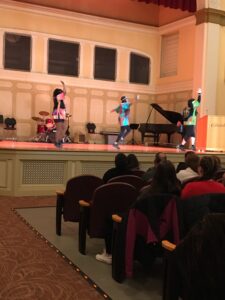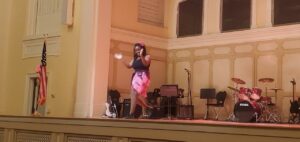Tuesday, February 13th, I attended a conference titled “The musical expression for African American Lived Experience”, covering African-American music. This conference was presented by Professor Lewis Rosengarten who is a music professor at SUNY Cortland. His presentation was very interesting and his speech was brilliantly supported by examples of music with the intention of introducing us to African American music and recognization of this community work. His presentation was very interesting and his speech was brilliantly supported by examples of music with the intention of introducing us to Afro-American music. During this conference, he chronologically explored the evolution of African-American musical styles from the time to the nowadays, including spirituals, gospel, ragtime, blues, jazz, rhythm and blues and rap, in order to show the impact on this music on the African-American community. Today, I find it interesting to briefly retrace the main aspects of the musical styles he described.
First of all, he stared talking about Spirituals, that were crucial for African Americans as they provided a means of expressing faith, hope, and resistance during the period of slavery. They served as a form of communal expression, offering solace and strength in the face of oppression. Spirituals allowed enslaved Africans to preserve cultural identity, communicate coded messages, and assert their humanity. They provided a sense of connection to their African roots while adapting to the new realities of life in America. Then, he made the transition between Spirituals and Gospel music. Gospel emerged from African-American churches and became a cornerstone of religious and cultural life. It served as a source of inspiration, comfort, and empowerment, reflecting the enduring faith and resilience of the community. Gospel music played a pivotal role in shaping African-American identity and fostering a sense of unity and solidarity. Its blend of Christian hymns with African musical traditions provided a platform for spiritual expression and communal worship. Furthermore, based on the listening of “Swipesy catwalk” by Scott Joplin, he talked about Ragtime music, saying that it emerged in the late 19th century as a synthesis of African rhythms, European melodies, and American popular music. It provided opportunities for African-American musicians to showcase their talent and creativity. Ragtime represented a form of cultural fusion and innovation, challenging racial stereotypes and paving the way for future generations of African-American musicians. Its syncopated rhythms and lively melodies captured the spirit of the time and influenced the development of jazz and other genres. Later, he discussed about blues, a music style originated in the Mississippi Delta among African-American communities in the late 19th and early 20th centuries. It served as a means of expressing the joys and sorrows of everyday life, offering a cathartic outlet for emotional expression. The blues provided a voice for marginalized communities, articulating experiences of hardship, love, and loss. Its raw emotion and honesty resonated with audiences worldwide, influencing the development of jazz, rock and roll, and other genres. Continuing with Jazz, he explained that it emerged in the early 20th century as a fusion of African rhythms, European harmonies, and American innovation. It became a symbol of cultural expression and artistic freedom, challenging conventions and pushing boundaries. Jazz provided African-American musicians with a platform for improvisation, collaboration, and self-expression. It reflected the spirit of innovation and resilience within the community and served as a catalyst for social change and cultural exchange. Moreover, he discussed about R&B saying that it evolved from the blues and gospel traditions in the mid-20th century, incorporating elements of jazz, rock and roll, and soul music. It became synonymous with the African-American experience, reflecting the joys and struggles of urban life. R&B provided a soundtrack for social and cultural movements, capturing the spirit of post-war America and the civil rights era. Its infectious rhythms and soulful vocals influenced popular music around the world, shaping the sounds of Motown, funk, and hip-hop. It provided a voice for disenfranchised youth, addressing issues of poverty, racism, and inequality. Finally, he finished his presentation talking about Rap music, explaining that it became a powerful tool for self-expression and activism, empowering African-American communities and challenging mainstream narratives. Originated in the Bronx in the 1970s as a form of street poetry and social commentary, its rhythmic delivery and lyrical complexity showcased the creativity and resilience of hip-hop culture, inspiring generations of artists and activists.
Overall, I really liked this presentation because it allowed me to learn more about musical styles and their origins. Passionate about music, particularly jazz and R&B, I really liked the passion he conveyed during his conference through his energy and his tone which was very cheerful. The thing that surprised me the most, I think, is the fact that R&B appeared so early (mid-20th century), when I thought it was a musical style specific to the 90s.


